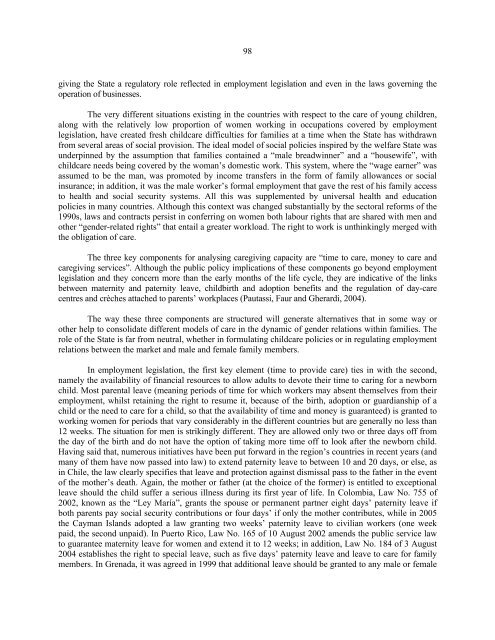Women in Latin America and the Caribbean - Cepal
Women in Latin America and the Caribbean - Cepal
Women in Latin America and the Caribbean - Cepal
Create successful ePaper yourself
Turn your PDF publications into a flip-book with our unique Google optimized e-Paper software.
98<br />
giv<strong>in</strong>g <strong>the</strong> State a regulatory role reflected <strong>in</strong> employment legislation <strong>and</strong> even <strong>in</strong> <strong>the</strong> laws govern<strong>in</strong>g <strong>the</strong><br />
operation of bus<strong>in</strong>esses.<br />
The very different situations exist<strong>in</strong>g <strong>in</strong> <strong>the</strong> countries with respect to <strong>the</strong> care of young children,<br />
along with <strong>the</strong> relatively low proportion of women work<strong>in</strong>g <strong>in</strong> occupations covered by employment<br />
legislation, have created fresh childcare difficulties for families at a time when <strong>the</strong> State has withdrawn<br />
from several areas of social provision. The ideal model of social policies <strong>in</strong>spired by <strong>the</strong> welfare State was<br />
underp<strong>in</strong>ned by <strong>the</strong> assumption that families conta<strong>in</strong>ed a “male breadw<strong>in</strong>ner” <strong>and</strong> a “housewife”, with<br />
childcare needs be<strong>in</strong>g covered by <strong>the</strong> woman’s domestic work. This system, where <strong>the</strong> “wage earner” was<br />
assumed to be <strong>the</strong> man, was promoted by <strong>in</strong>come transfers <strong>in</strong> <strong>the</strong> form of family allowances or social<br />
<strong>in</strong>surance; <strong>in</strong> addition, it was <strong>the</strong> male worker’s formal employment that gave <strong>the</strong> rest of his family access<br />
to health <strong>and</strong> social security systems. All this was supplemented by universal health <strong>and</strong> education<br />
policies <strong>in</strong> many countries. Although this context was changed substantially by <strong>the</strong> sectoral reforms of <strong>the</strong><br />
1990s, laws <strong>and</strong> contracts persist <strong>in</strong> conferr<strong>in</strong>g on women both labour rights that are shared with men <strong>and</strong><br />
o<strong>the</strong>r “gender-related rights” that entail a greater workload. The right to work is unth<strong>in</strong>k<strong>in</strong>gly merged with<br />
<strong>the</strong> obligation of care.<br />
The three key components for analys<strong>in</strong>g caregiv<strong>in</strong>g capacity are “time to care, money to care <strong>and</strong><br />
caregiv<strong>in</strong>g services”. Although <strong>the</strong> public policy implications of <strong>the</strong>se components go beyond employment<br />
legislation <strong>and</strong> <strong>the</strong>y concern more than <strong>the</strong> early months of <strong>the</strong> life cycle, <strong>the</strong>y are <strong>in</strong>dicative of <strong>the</strong> l<strong>in</strong>ks<br />
between maternity <strong>and</strong> paternity leave, childbirth <strong>and</strong> adoption benefits <strong>and</strong> <strong>the</strong> regulation of day-care<br />
centres <strong>and</strong> crèches attached to parents’ workplaces (Pautassi, Faur <strong>and</strong> Gherardi, 2004).<br />
The way <strong>the</strong>se three components are structured will generate alternatives that <strong>in</strong> some way or<br />
o<strong>the</strong>r help to consolidate different models of care <strong>in</strong> <strong>the</strong> dynamic of gender relations with<strong>in</strong> families. The<br />
role of <strong>the</strong> State is far from neutral, whe<strong>the</strong>r <strong>in</strong> formulat<strong>in</strong>g childcare policies or <strong>in</strong> regulat<strong>in</strong>g employment<br />
relations between <strong>the</strong> market <strong>and</strong> male <strong>and</strong> female family members.<br />
In employment legislation, <strong>the</strong> first key element (time to provide care) ties <strong>in</strong> with <strong>the</strong> second,<br />
namely <strong>the</strong> availability of f<strong>in</strong>ancial resources to allow adults to devote <strong>the</strong>ir time to car<strong>in</strong>g for a newborn<br />
child. Most parental leave (mean<strong>in</strong>g periods of time for which workers may absent <strong>the</strong>mselves from <strong>the</strong>ir<br />
employment, whilst reta<strong>in</strong><strong>in</strong>g <strong>the</strong> right to resume it, because of <strong>the</strong> birth, adoption or guardianship of a<br />
child or <strong>the</strong> need to care for a child, so that <strong>the</strong> availability of time <strong>and</strong> money is guaranteed) is granted to<br />
work<strong>in</strong>g women for periods that vary considerably <strong>in</strong> <strong>the</strong> different countries but are generally no less than<br />
12 weeks. The situation for men is strik<strong>in</strong>gly different. They are allowed only two or three days off from<br />
<strong>the</strong> day of <strong>the</strong> birth <strong>and</strong> do not have <strong>the</strong> option of tak<strong>in</strong>g more time off to look after <strong>the</strong> newborn child.<br />
Hav<strong>in</strong>g said that, numerous <strong>in</strong>itiatives have been put forward <strong>in</strong> <strong>the</strong> region’s countries <strong>in</strong> recent years (<strong>and</strong><br />
many of <strong>the</strong>m have now passed <strong>in</strong>to law) to extend paternity leave to between 10 <strong>and</strong> 20 days, or else, as<br />
<strong>in</strong> Chile, <strong>the</strong> law clearly specifies that leave <strong>and</strong> protection aga<strong>in</strong>st dismissal pass to <strong>the</strong> fa<strong>the</strong>r <strong>in</strong> <strong>the</strong> event<br />
of <strong>the</strong> mo<strong>the</strong>r’s death. Aga<strong>in</strong>, <strong>the</strong> mo<strong>the</strong>r or fa<strong>the</strong>r (at <strong>the</strong> choice of <strong>the</strong> former) is entitled to exceptional<br />
leave should <strong>the</strong> child suffer a serious illness dur<strong>in</strong>g its first year of life. In Colombia, Law No. 755 of<br />
2002, known as <strong>the</strong> “Ley María”, grants <strong>the</strong> spouse or permanent partner eight days’ paternity leave if<br />
both parents pay social security contributions or four days’ if only <strong>the</strong> mo<strong>the</strong>r contributes, while <strong>in</strong> 2005<br />
<strong>the</strong> Cayman Isl<strong>and</strong>s adopted a law grant<strong>in</strong>g two weeks’ paternity leave to civilian workers (one week<br />
paid, <strong>the</strong> second unpaid). In Puerto Rico, Law No. 165 of 10 August 2002 amends <strong>the</strong> public service law<br />
to guarantee maternity leave for women <strong>and</strong> extend it to 12 weeks; <strong>in</strong> addition, Law No. 184 of 3 August<br />
2004 establishes <strong>the</strong> right to special leave, such as five days’ paternity leave <strong>and</strong> leave to care for family<br />
members. In Grenada, it was agreed <strong>in</strong> 1999 that additional leave should be granted to any male or female











